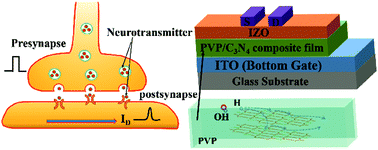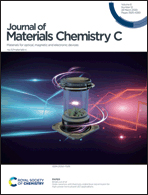Aqueous-solution-processed proton-conducting carbon nitride/polyvinylpyrrolidone composite electrolytes for low-power synaptic transistors with learning and memory functions†
Abstract
Brain-inspired neuromorphic devices have recently received increasing attention because of their unique characteristics, such as learning/memory function and low power consumption. However, the development of synaptic transistors with ultra-low operating voltage, excellent learning/memory function and low manufacturing cost is still a huge challenge in simulating artificial synapses. In this work, a new strategy of aqueous-solution-processed proton-conducting carbon nitride/polyvinylpyrrolidone (C3N4/PVP) composite electrolytes is proposed for fabricating an InZnO synaptic transistor. The synaptic transistor shows a high mobility of 75.4 cm2 V−1 s−1 and an ultralow threshold voltage of 0.33 V. The paired pulse facilitation (PPF), paired pulse depression (PPD) short-term memory and long-term memory of the device are successfully exhibited. The minimum power consumption of a single pulse is 0.32 nJ. In addition, “AND” and “YES” logic operations are implemented in the synaptic transistor. The traditional Pavlovian conditioning is successfully imitated in our equipment, which presents excellent memory and learning ability. This work opens up a new avenue to achieve high performance synaptic transistors, which provides a valuable means for developing neuromorphic electronics.



 Please wait while we load your content...
Please wait while we load your content...